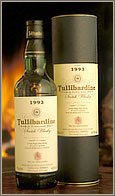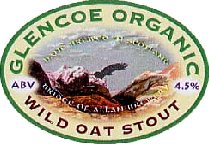 |
 |
|

|
|
|
 |

home
about
features
A-Z
books

|

|

features
|

| |

|
|
Gavin D Smith
Gavin is probably best known as an authority on Scotch whisky and brewing. He is the author of 15 books, including the Scottish Beer Bible. He contributes to a wide range of
specialist and general interest publications and is currently working on three new whisky-related titles, due for publication in 2005 and 2006. Gavin is married and lives on the Fife coast.
|
Tullibardine - Whisky Ale
by Gavin D Smith
The brewing of beer is very similar to the distilling of whisky until the point in distilling where wash is pumped into the stills. Brewing terms such as 'sparging' are also used in the whisky industry, and, traditionally, one of the key members of distillery staff was 'The Brewer'.
A significant number of distilleries were formerly breweries, the highest profile being Glenmorangie, at Tain in Easter Ross. Glen Moray distillery in Elgin was Henry Arnot's West Brewery until its conversion in 1897, and the now sadly abandoned Victorian Brauhaus-style Deuchar's Brewery in the east coast town of Montrose worked as Lochside distillery from 1957 until its closure in 1992.
Given that the two crafts have so much in common, it is not surprising that brewers have already flirted with whisky-makers on a number of occasions. The French beers Adelscott from Brasserie Fischer and Kronenbourg's Wel Scotch are both brewed using peat-smoked Scotch whisky malt, while Clackmannanshire-based Ken Brooker matured his Harviestoun Special Reserve Old Engine Oil in casks which had previously contained Dalmore single malt whisky.
Innis & Gunn fill their Oak Aged Beer into fresh American White Oak barrels, later destined for the whisky industry, and mature it for a period of 30 days in a warehouse on the west coast of Scotland. This venture was inspired by William Grant & Sons Ltd's use of the Caledonian Brewery's Edinburgh Strong Ale casks to finish their Ale Cask Reserve blended whisky.
However, the latest collaboration between beer and whisky-makers, featuring Stirlingshire's Bridge of Allan Brewery, headed by Douglas Ross, and Tullibardine distillery, also represented by a (different) Douglas Ross, is not so much flirting as a full blown affair.
Tullibardine distillery was established in the Perthshire village of Blackford in the late 1940s. It stands on the site of Scotland's oldest public brewery, which dates from the
12th century. Following his coronation at nearby Scone in 1488, King James 1V purchased beer from the brewery, which operated until the early 1900s.
Tullibardine distillery was mothballed in 1994, but in 2003 a business consortium purchased and re-opened the plant, going on to create a new retail development on the site, which is situated beside the busy A9 Glasgow-
Perth road.
What the Tullibardine distillers have done to commemorate the long-standing link between brewing and distilling in this historic location is really remarkably radical, and the result is Blackford 1488 Majestic Whisky Ale, brewed to 7%, and officially launched in January.
|
|

|
According to Bridge of Allan's Douglas Ross, "We take the distillery grist, containers of its water, and distiller's yeast from the distillery to the brewery, and make the beer there.
"I was concerned at first that the Optic barley used by the distillery might produce off-notes," he admits, "not being a recognised brewing variety of barley, and having a lower phenol content, but it actually works very well, it just takes longer to ferment. The effect of the distiller's yeast is also a longer period of fermentation, it ferments more sugar, which is one of the reasons why this is a strong ale."
Tullibardine director Douglas Ross explains that "We deliver freshly disgorged casks - at the moment 1993 bourbon casks - and Douglas puts the ale in them to mature for six to eight weeks before he bottles it. We're really still experimenting with the optimum maturation period, and it may well change."
The beer is only lightly hopped, and the brewer Douglas Ross says "What excites me is how the flavour has taken on the character of the Tullibardine malt. It's subtle but delicious, and there's a fabulous whisky aftertaste."
His Tullibardine counterpart concurs. "I think it's a delicately fruity beer," he says, "light in body, deceptively so for 7%, with a hint of Tullibardine whisky in the nose.
"I'm convinced the character of Tullibardine comes through in the beer. It's the same water and barley, the same yeast and the same barrels for both. You really do taste the whisky. You get the same vanilla trace elements and orange notes that are characteristic of the Tullibardine whisky."
Bridge of Allan is geographically the closest brewery to Tullibardine, but was also chosen to partner the distillery in this new venture because, as Tullibardine's Douglas Ross puts it, "Bridge of Allan Brewery has been recognised for the quality of its beers with numerous awards, and Douglas Ross is a very innovative guy, always keen to try new ideas."

|
|
Established in August 1997, and noted for such brews as the Tesco Beer Challenge Winner City of Stirling 80/- Ale, Stirling Brig and Glencoe Wild Oat Stout, Bridge of Allan's capacity was augmented by the nearby
20-barrel City of Stirling Brewery in December 2003.
A bottle-conditioned version of Whisky Ale is currently being trialled at Bridge of Allan Brewery, which is responsible for the current CAMRA Champion Bottle-conditioned Beer of Scotland, Brig O'Allan 80/- Ale.
|
"At the moment Whisky Ale is only on sale in our visitor centre at the distillery, but we expect it to be available from a selection of specialist retailers, too," says Tullibardine's Douglas Ross. "Production is limited to the number of casks we disgorge, really. We started by brewing just four casks, and if we sell three to four thousand cases of Tullibardine single malt whisky in a year, that's roughly 300 casks per year. You'll get about 160 bottles of ale out of a cask, so that's the scale we expect to operate on.
"We can see people sitting with a nip of Tullibardine and a bottle of this. It sells at around �3.95 for a 500 ml bottle, so we don't see people buying six to sit and swig in a session. We think they might buy some for a dinner party, for example, and put bottles on the table along with wine.
"Our aim is to keep it as true to the distilling process as possible," he explains. "There's no artificial colouring, the same as with our whisky, the colour comes from the beer itself and from the wood. We deliberately chose to use brown glass bottles so that the great, rich golden colour comes as a welcome surprise when you pour it. The bottles are hand wax-sealed and hand-labelled.
"At one time there were three breweries working in the village of Blackford, and we always wanted to produce something that recognised the brewing heritage of our site. Without putting a brewery on the site this is the most authentic way of producing a beer. It's as close to having a micro-brewery in a distillery as you can get. For us, producing the ale is part of our plans for differentiation and innovation. 1488 was the year King James bought ale from the brewery here, and '1488' is a brand we will look to develop."
As single malt aficionados appreciate, no two casks produce identical whiskies, even if filled with the same 'make' on the same day and stored in the same warehouse for an identical period of time. To an extent, this must influence the character of Whisky Ale from batch to batch. As Tullibardine's Douglas Ross says, "If you want homogenous products go elsewhere. That's not what we're about."
For lovers of cask ales with local provenance, there is much to admire in the world of single malt whiskies, where geographical identity is central to the product's integrity.
If you can, get hold of a bottle of Whisky Ale, along with a nip or two of 1993 Tullibardine single malt, and see whether you agree with Douglas Ross and Douglas Ross about the influence of the whisky on the beer. Personally, I think it's a dram fine ale...
|
|
home
about
features
A-Z
books
|